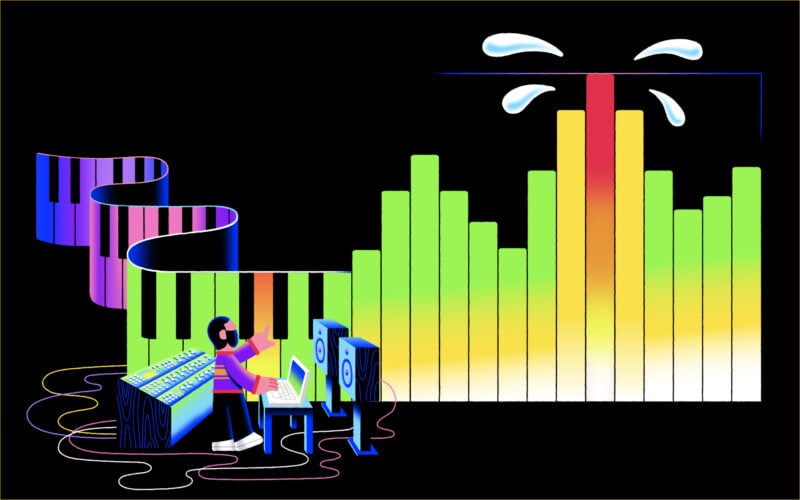Illustration: Filip Fröhlich
Have you ever heard the terms “inter-sample peak” or “true peak” thrown around in the world of mastering and wondered what they meant?
Why is there more than one kind of peak, and what makes this one more “true” than what we may be most familiar with? We’re going to answer exactly that in this article—but first, let’s cover some important context relevant to inter-sample peaks.
The fundamentals of digital audio
While various forms of audio recording have been present since the early 1900s, the digital domain for multi-track audio production is still relatively new. One of the more recent concerns is that our DAWs’ traditional meters are not giving us an accurate picture of how loud the sound is—specifically where the “true” peaks are.
The digital domain has an absolute limit for sound. This limit is referred to as 0 dBFS (“zero decibels relative to full scale”). This means that absolutely no sound passes this limit. Any peaks that do will be promptly chopped off (also known as digital clipping).
But, the problem here is that while sound in the real world is continuous, the measurement of sound in the digital domain is not. In order for a computer or digital device to process sound for us to manipulate, it must “measure” the sound and convert it from its natural analog state into a digital one. This analog-to-digital conversion happens by sampling the sound at discrete points in time. The rate at which the digital device samples is called the sample rate. Below, you can see a visualization of a sound being sampled at 48 kHz per second, where each dot represents a snapshot taken by the A/D converter:

From this, our DAW will connect the dots and reconstruct the sound. When you zoom out, you see a waveform:

As you can see, there are several sharp, thin peaks in the waveform. Luckily for us, they’re nowhere near the top, which would be the 0 dBFS ceiling we mentioned before. But, what happens if we turn this sound way up?

Now, those spikes are hitting our digital ceiling and being chopped off (or “clipped”). This is how it looks in our DAWs’ meters when a waveform hits 0 dBFS:

Why (and where) inter-sample peaks occur
So if we have a digital ceiling that doesn’t allow anything past it, what is there to worry about? Is there really a problem with using tools like limiters to push our levels right up to the ceiling? After all, louder is better… right?
The issue comes when our digital signal needs to be converted back to analog for speakers and headphones. Since the A/D converter is only capable of sampling at a certain rate and at discrete points in time, we’re not getting truly continuous sampling. The converter is taking snapshots at an extremely high rate, but there’s still a chance that something spikes between one of the snapshots.


This occurs because the digital device doesn’t actually “see” information between the samples; it just creates a smooth visualization for reference. However, when the digital signal is converted back to analog (D/A), the curve that creates peaks between samples is accurately reconstructed, potentially creating distortion that wasn’t present before the D/A conversion.
How to avoid inter-sample peaks
The easiest way to avoid inter-sample peaks is to just leave room for them! Sometimes, leaving as little as 0.3 dB of headroom can make a difference. But, if you want to be extremely diligent about it, you can use metering tools that measure true peaks (such as the free YouLean Loudness Meter) and limiting tools that prevent them (such as FabFilter’s Pro-L 2).
Do you need to worry about inter-sample peaks?
How much do we need to worry about inter-sample peaks? When do they become a problem? Let’s start by addressing the latter:
- Smaller, lower-quality playback devices that don’t have a lot of headroom may sound distorted when ISPs occur. But, on most devices with decent headroom, this shouldn’t be as much of a problem.
- ISPs can cause clipping when converting from a .wav or AIFF file to a lossy audio file such as an mp3. This type of compression can reconstruct the peaks and create distortion.
- If your signal has multiple destinations after being converted, there’s more of a chance that ISPs will cause issues.
As far as the former is concerned, let’s examine the true peak measurements of some of the most popular songs in recent history. Below are a few songs that exceed 0 dBTP:
- Travis Scott and Drake’s “Sicko Mode” (2.4 dBTP)
- Dua Lipa’s “Levitating” (1.8 dBTP)
- Doja Cat’s “Say So” (0.8 dBTP)
- Carly Rae Jepsen’s “Call Me Maybe” (0.8 dBTP)
- Mariah Carey and Boyz II Men’s “One Sweet Day” (0.7 dBTP)
- Bruno Mars’ “Uptown Funk” (0.4 dBTP)
As it turns out, many professional, modern-day commercial mixes are riddled with inter-sample peaks! With all of this in mind, how much do you think we should worry about inter-sample peaks / true peaks? Let us know in the comments below.
Explore royalty-free sounds from leading artists, producers, and sound designers:
September 20, 2021



